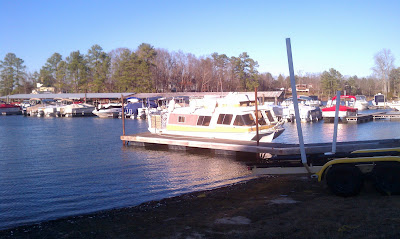Big Duck has very basic plumbing.
Freshwater tankDemand pump
Water heater (currently 120vac only, but plumbed for engine heating)
GalleyHead
Shower
To winterize I need to drain both the freshwater tank and the hot water tank and then push RV antifreeze through all the hot and cold pipes. This means loosening many hose clamps, pulling the hoses off and reconnecting them to various other places/things.
My travel trailer had a simple system for winterizing. A separate feed at the tank to pickup antifreeze out of a bottle and a hotwater tank drain and bypass. I wanted a similar system for the boat so I wouldn't hesitate to un-rewinterize for cruises during nice winter weather. This was also a good time to update the hoses.
The trailer used T's and valves with hard plastic water lines. My boat water goes thru 5/8" hose -- the same size as standard garden hose, so I used garden hose fittings.
I had a bunch of plastic fittings already, so I used all plastic. We'll see how they hold up for the hot water side. Worst case we'll get some water in the bilge and I'll get the metal fittings.
So now, to winterize I can easily switch the valves to drain the hot water tank rather than filling it with 6 gallons of antifreeze and then bypass it. Then pull the intake hose off the copper line that runs from the tank, stick it in the gallon of RV antifreeze, turn on the pump and bleed each hot and cold faucet until I see the pink stuff coming out. I'd already installed a drain valve on the water tank and to protect the line from the pump to the tank I feed a little antifreeze back into it.
Then I remembered a little tool in my toolbox that I had seemed awkward to use...thought I'd give it another crack. It's a gizmo that makes hose clamps from wire. Nice thing about the finished product is that there's no bulging screw and no metal tab protruding to gouge your hand on.
A close up here of what my practice clamp looks like. The booklet says it will even do a hydraulic fitting. Unlike the standard hose clamp, they're not reusuable - you need to cut them off. For my 1" OD hose I need about 20" of stainless wire for each clamp.
And while I was in there, I decided to make the bypass out of clear tubing that would allow me to not only see the fluid moving but it also make a tighter bend so I could use a shorter hose.
So I decided that once I got the hang of it, the Clamptite tool wasn't so bad after all - especially on hoses that are easy to get to.



































